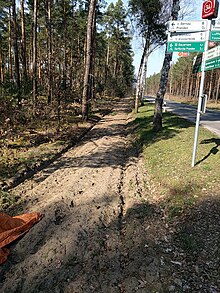Firebreak

A firebreak is a strip several meters wide in forests, large-scale meadows and heaths , settlements and other large - scale facilities that are at risk of fire . Within this strip, the amount of combustible material (trees, bushes, buildings or the like) is reduced to a minimum, depending on the environment, so that this gap represents an obstacle that is difficult to overcome for a fire in the spread of a fire, for example a forest fire .
Firebreaks are mostly of artificial origin (e.g. through clearing in forests), but natural conditions, such as a wide river or a rocky mountain ridge , can also represent firebreaks. Wide streets can also act as a firebreak in densely populated large urban areas.
Depending on the degree of precautions, fire breaks in forestry can be classified as follows:
- Forest fire bar: strips up to 300 m wide with fire-retardant vegetation
- Forest fire protection strips : strips up to 30 m wide from which fire loads (dead wood, scrub) are continuously removed
- Forest fire sore strips : strips that are kept free of combustible humus by regular plowing and harrowing and are thus intended to prevent the spread of ground fires . They are usually one meter wide.
In the event of major fires, firebreaks are also used as active fire fighting through clearing .
Web links
- Forest Fire Study 2016 (accessed on February 28, 2020)
- The forest in the Maritime Alps département / southern France Forest pollution, consequences and structure of forest functions (accessed on February 28, 2020)
- Forest Fire Prevention (accessed February 28, 2020)
- Forest fire bar (accessed February 28, 2020)
- Study material on the topic of forest fire protection (accessed on February 28, 2020)
Individual evidence
- ↑ Henry Portz: Fire and Explosion Protection from A – Z: Explanation of terms and fire protection characteristics. 2005. Springer Vieweg. ISBN 978-3-322-80197-5 .
- ↑ Silvicultural forest fire prevention. In: waldwissen.net. Retrieved August 4, 2016 .
